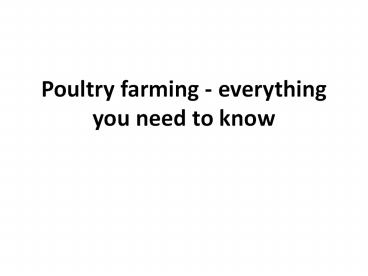Poultry farming - everything you need to know PowerPoint PPT Presentation
Title: Poultry farming - everything you need to know
1
Poultry farming - everything you need to know
2
- Poultry farming is the husbandry of domesticated
birds such as chickens, ducks, turkeys, and
geese, primarily for the purpose of producing
meat or eggs. - Most people are coming to this business because
of the high returns that can be obtained in a
short period of time. - Layers are chickens raised for eggs, whereas
broilers are chickens raised for meat.
3
Methods of poultry farming
- Farmers use a number of different methods to
achieve the best results, including intensive and
free-range farming.
4
Intensive farming
- Intensive farming is a method of increasing
production while controlling costs. - To accomplish this, animals are kept at high
stocking densities in confined spaces on a large
scale. - Modern poultry equipment and technology are used
to control environmental conditions such as the
climate in which these birds are kept. - Layers do not thrive in winter, resulting in a
reduction in egg production, but in controlled
environments, the climate can be kept at the
right conditions throughout the year, allowing
layers to produce all year.
5
Free-range farming
- Free-range farming is an approach that allows
animals to roam freely for some of the day rather
than being confined for the entire 24 hours. - The area that is roamed is usually fenced, but
this still allows chickens to move around freely
and behave naturally. - With free range farming, you have limited control
over what the chickens consume.
6
Period of expansion
- Hens (layers) begin laying eggs between the ages
of 16 and 21 weeks, and some breeds can lay up to
300 eggs per year. - After 25 weeks of age, production may begin to
decline. - Broilers are frequently raised in an intensive
environment, reaching slaughter weight between
the ages of 5 and 9 weeks. - In the first week, broilers can gain 300 percent
of their body weight. - These birds are raised in large open structures
known as growout houses, rather than cages. - Growout houses have ventilation and heating
systems, and a single growout house measuring
400/500 ft long and 40/50 ft wide can house up to
20 000 broilers.
7
Feeding
- Chickens are omnivores and will eat almost
anything, but a proper feed diet should include
corn, soybean (high protein), omena, and
additional vitamins and minerals to ensure the
chickens' nutritional needs are met. - Poor feed quality causes slow growth, low egg
production, and makes chickens susceptible to
disease.
8
Antibiotics
- Antibiotic-treated chickens grow 50 percent
faster, lay more eggs, have lower mortality, and
are less ill. - Chickens typically reach market weight more
quickly and at a lower cost.
9
Advantages of Poultry Farming
- Poultry farming does not require a lot of capital
to get started as a business. - It is entirely possible to start on a small
scale. - High and rapid returns on investment in a very
short period of time, with returns accessible
within 10 weeks of starting the business. - Ease of expansion and rapid increase in
production. - High demand, chicken is consumed globally and is
in high demand.
10
- Because a chicken is considered a domesticated
animal, no special licences or permits are
required. - Takes up little space and can be started in your
own backyard. - Needs little water for drinking and cleaning one
litre is enough for 5 chickens per day. - Marketing costs are lower because chickens are
not usually sold directly from the farmer to the
consumer, but rather through markets and other
establishments. - Ease of access to capital from banks and the
government.
11
Poultry Equipment
- To get started, you don't need much machinery or
equipment, but if you want to produce
commercially, you'll need Poultry equipment to
meet the demands of running a commercial poultry
farm. - Feeding system.
- Drinking / watering system.
- Climate control system.
- Housing.
- Adequate flooring.
- Bird transport.
- Medicator / vaccinator

